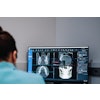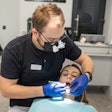A new test may detect a germ-fighting protein associated with oral cancer, track precancerous lesions, and determine when a biopsy is necessary. The study was recently published in Cell Reports Medicine.
The beta defensin index (BDI) test can identify levels of human beta defensin 3 (hBD 3), which supports tumor growth and is found in higher amounts in the early stages of oral squamous cell carcinoma (OSCC), and hBD 2, a protein that is downregulated in oral carcinoma cells. Detecting the varying levels of these proteins in this point-of-care (POC) test allows for the differentiation between cancerous and noncancerous lesions, the authors wrote.
 Dr. Aaron Weinberg, PhD. Image courtesy of Case Western University.
Dr. Aaron Weinberg, PhD. Image courtesy of Case Western University.
"One of the benefits of using the BDI would be the reduction of unnecessary biopsies conducted by dentists in the United States," wrote the authors, led by Dr. Aaron Weinberg, PhD, the chair of the department of biological sciences at the Case Western Reserve School of Dental Medicine (Cell Rep Med, March 4, 2024).
Diagnosing early malignant OSCC lesions can be difficult due to a reliance on histology, which has variable inter-rater reliability. Biopsies, the current method, are costly, invasive, and may lead to complications, they wrote.
Initially, researchers examined eight patients -- four with OSCC lesions and four with noncancerous lesions. They found that the BDI was significantly higher (p = 0.02) in those with cancerous lesions compared to those with noncancerous ones.
Further studies showed that BDI accurately distinguished between cancerous and noncancerous lesions, with high sensitivity (98.2%) and specificity (82.6%). Additionally, they demonstrated that BDI could be measured using a POC device using microfluids.
However, the study had some drawbacks. Unlike tests that use saliva or blood for detecting oral cancer, BDI requires that a suspicious lesion be visible and easy to reach for collecting enough cells, they wrote.
"These results support BDI as a promising index for screening OSCC and may serve as a triage tool before traditional biopsy," Weinberg et al wrote.




















